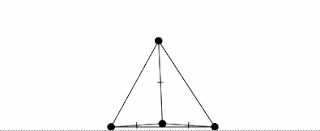
My first try in
IFS fractals iterated from simple equations.
They are created from the following equation, You start with any x0,y0 and iterate ti get the pixels to draw x1,y1 and then x2,y2 and so on.
Use the formula:
x = a11 * x0 + a12 * y0 + c1;
y = a21 * x0 + a22 * y0 + c2;
where a's and c's take from the tables.
The tree:
// a11 a12 a21 a22 c1 c2 s J

double a1[4][8]= { {-0.67, -0.02, -0.18, 0.81, 0.00, 1.02, 0.8530, 0.546},
{ 0.40, 0.40, -0.10, 0.40, -0.04, 0.06, 0.6217, 0.200},
{-0.40, -0.40, -0.10, 0.40, 0.04, 0.06, 0.6217, 0.200},
{-0.10, 0.00, 0.44, 0.44, 0.00, -0.14, 0.6263, 0.044}
};
The leave:
double a1[4][8]= { {0.240, -0.007, 0.007, 0.015, 0.000, 0, 0.004},
{0.220, -0.330, 0.360, 0.100, 0.540, 0, 0.149},
{0.140, -0.360, -0.380, -0.100, 1.400, 0, 0.160},
{0.800, 0.100, -0.100, 0.800, 1.600, 0, 0.687}
};
The code written here was C++ with PPM output. The number of iterations was
1e11 for leave and 1e9 for tree.
by Maciej Matyka (motivated by K. Graczyk :-)
Literature: J. Kudrewicz, Fraktale i chaos, WNT 2015
Update:
see animated version here!.
p.s. The full C++ code that produces these pictures is given below:
---- code starts here
#include <cstdlib>
#include <iostream>
#include <fstream>
#include <ctime>
#include <random>
using namespace std;
const double xmin = -2.25;
const double xmax = 2.25;//15;
const double ymin = 0;
const double ymax = 5;
const double dx = (xmax-xmin);
const double dy = (ymax-ymin);
const int W=int(dx*280);
const int H=int(dy*280);
int pixels[W][H]={0};
//vector<float> X;
//vector<float> Y;
void plot(double x, double y)
{
int mx = int((x+dx/2)*W/dx); // -1.25 : 1.25
int my = int((y)*H/dy); // 0 : 6
if(mx<W&&mx>0&&my>0&&my<H)
{
pixels[ mx ][ my ] = 1;
}
}
void saveppm()
{
ofstream file("pix.ppm");
int c;
file << "P3" << endl;
file << "# dkfjsdljf" << endl;
file << W << " " << H << endl;
file << 255 << endl;
for(int j=0; j<H; j++)
{
for(int i=0; i<W; i++)
{
c = 255-pixels[i][H-j] * 255;
file << c << " " << c << " " << c << " ";
}
file << endl;
}
file.close();
}
// two stressed pilots
int main()
{
double x,y;
double x0,y0;
mt19937 mt_rand(time(0));
srand(time(NULL));
// J. Kudrewicz, p. 24
// a11 a12 a21 a22 c1 c2 s J
// choinka
double a1[4][8]= { {-0.67, -0.02, -0.18, 0.81, 0.00, 1.02, 0.8530, 0.546},
{ 0.40, 0.40, -0.10, 0.40, -0.04, 0.06, 0.6217, 0.200},
{-0.40, -0.40, -0.10, 0.40, 0.04, 0.06, 0.6217, 0.200},
{-0.10, 0.00, 0.44, 0.44, 0.00, -0.14, 0.6263, 0.044}
};
// paproc
/* double a1[4][8]= { {0.240, -0.007, 0.007, 0.015, 0.000, 0, 0.004},
{0.220, -0.330, 0.360, 0.100, 0.540, 0, 0.149},
{0.140, -0.360, -0.380, -0.100, 1.400, 0, 0.160},
{0.800, 0.100, -0.100, 0.800, 1.600, 0, 0.687}
};*/
// iterate
x0=0.1;
y0=0.6;
long int step=0;
int i;
const long int ITERATIONS = 1000000000;
//cout << mt_rand() << endl;
//return 0;
while(step++ < ITERATIONS)
{
//i = rand()%4; // 0-3
i = mt_rand()%4;
x = a1[i][0] * x0 + a1[i][1] * y0 + a1[i][4];
y = a1[i][2] * x0 + a1[i][3] * y0 + a1[i][5];
plot(x,y);
x0=x; y0=y;
if(!(step % (ITERATIONS/50)))
cout << "*";
}
cout << step << endl;
saveppm();
return 0;
}
---- code ends here





